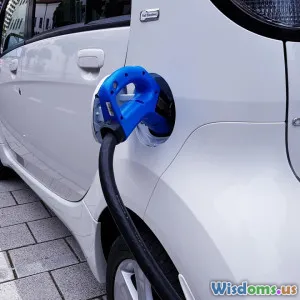
Do Electric Cars Really Cost Less to Insure
11 min read Explore whether electric cars truly offer lower insurance costs by analyzing factors impacting premiums and real-world data. (0 Reviews)
Do Electric Cars Really Cost Less to Insure?
Electric vehicles (EVs) have experienced a meteoric rise in popularity over recent years, propelled by advances in technology, government incentives, and mounting environmental concerns. As more consumers consider making the switch to electric, one pressing question frequently arises: do electric cars really cost less to insure?
At first glance, you might think yes. EV owners tout savings in fuel costs, maintenance, and emissions taxes — so why shouldn’t insurance be cheaper too? The answer, however, is more complex. Insurance premiums reflect various factors including repair costs, safety records, risk profiles, and market conditions, all of which influence whether EVs are cheaper or more expensive to cover.
Let’s take a deeper dive to unravel the truths behind electric car insurance costs, dissect the factors shaping premiums, analyze real-world data, and ultimately empower you to make an informed decision about insurance for your electric vehicle.
Understanding How Car Insurance Premiums Are Determined
Before comparing electric and traditional internal combustion engine (ICE) vehicles, it's crucial to understand how insurance companies calculate premiums.
Insurance companies primarily consider:
- Vehicle value: More expensive cars generally incur higher premiums.
- Repair costs and parts availability: The cost and ease of fixing a car post-accident heavily influence rates.
- Safety ratings: Cars with advanced safety features or higher crash-test scores typically attract lower premiums.
- Theft rates: Higher risk of theft can increase premiums.
- Driver profile and usage: Age, driving record, location, and mileage all play significant roles.
- Claims history: Past claims on similar vehicle models matter.
Unlike fuel costs or taxes, insurance premiums are not directly tied to fuel efficiency or zero tailpipe emissions. Hence, insurance costs may or may not correlate with the cost-savings of driving electric.
Electric Vehicles: Factors Driving Insurance Rates
1. The Price Tag and Repair Costs
EVs tend to have a higher sticker price than comparable petrol cars, partially because of expensive battery packs and often premium technology packages. A higher vehicle value inherently pushes insurance costs upwards.
Furthermore, repair costs on EVs are often pricier and more specialized. For example:
- EV batteries cost thousands of dollars to replace.
- Repairing electric drivetrains requires specialized technicians.
- Replacement parts may be sourced from fewer providers or directly from manufacturers, which can raise costs.
According to a 2022 study from RepairPal, the average annual repair cost for electric cars is approximately $460, compared to $520 for traditional turbocharged gas vehicles.
While that suggests EVs might be cheaper to maintain in the long run, insurance-related repair claims often involve expensive collision or battery repairs instead of routine maintenance.
2. Advanced Safety Features and Crash Data
Many electric vehicles come equipped with the latest safety tech, such as:
- Automatic emergency braking (AEB)
- Lane departure warnings
- Adaptive cruise control
These systems can lower the likelihood of accidents, which in theory should reduce insurance rates. Additionally, the structural design of EVs, including reinforced battery housings, can improve crashworthiness.
Research by the Insurance Institute for Highway Safety (IIHS) found several EVs earning high safety ratings, potentially lowering insurance premiums.
3. Theft and Damage Risks
Traditional vehicles sometimes face theft risks, but EVs introduce new concerns, such as:
- Cyberattacks due to high connectivity
- Targeted theft of EV batteries
On the other hand, GPS tracking and immobilizers embedded within EVs may reduce theft rates.
4. Market Dynamics and Insurance Company Strategies
A significant factor is how insurers price EVs in the market:
- Some companies have yet to develop precise pricing models for electric cars and may initially charge higher premiums due to uncertainty.
- Competition among insurers targeting eco-conscious consumers can lead to special EV discounts.
- In some states or regions, mandates or incentives impact insurance policy pricing.
Real-World Data and Comparative Analysis
Insurance Premium Comparisons
Several real-world insurance comparisons shed light on how premiums differ between EVs and ICE cars.
According to a 2023 report by NerdWallet:
- The average annual insurance cost for a Tesla Model 3 (EV) was about $1,400.
- A comparable ICE sedan like the BMW 3 Series averaged approximately $1,300 annually.
This data highlights a slight difference but not a dramatic savings for EVs.
Similarly, a study from Insurify in 2022 revealed:
| Vehicle Model | Average Annual Insurance Cost |
|---|---|
| Nissan Leaf (EV) | $1,150 |
| Toyota Corolla (ICE) | $1,080 |
Slightly higher for EV, but close.
These numbers show EVs can sometimes cost marginally more to insure, mainly driven by repair and replacement costs.
Examples of Insurers Offering EV Discounts
Some specialized insurance providers understand the importance of supporting green initiatives and offer perks:
- Geico: Offers Green Car Discounts for qualifying EV drivers in certain states.
- Progressive: Targets EV owners with discounts reflecting safety features.
- Tesla Insurance: Offers competitive rates with direct access to Tesla’s repair network.
As insurer familiarity with EV technology improves, competitive pricing is expected to better reflect actual risks and repair costs.
Debunking Common Myths About EV Insurance Costs
Myth 1: Electric Cars Are Cheaper to Insure Because They Are Environmentally Friendly
While eco-friendly status matters to some insurers' brand image, insurance premiums remain primarily risk- and cost-based. Simply being 'green' does not lower your insurance by default.
Myth 2: EV Batteries Make Cars Significantly More Expensive to Insure
The battery packs are expensive to replace, but total claims frequency for EVs remains relatively similar or even lower than ICE cars, balancing some risk factors.
Myth 3: Charging Habits and Range Affect Insurance
Charging style or battery range generally do not impact insurance directly, although usage-related factors like daily mileage do.
Future Trends and Considerations
Increased Availability and Repair Infrastructure
As EV adoption grows, more independent repair shops and insurers gain experience, likely reducing repair delays and costs that currently inflate premiums.
Telematics and Usage-Based Insurance
EV owners often benefit from telematics devices tracking driving patterns. Safe driving can translate into lower insurance premiums based on actual risk.
Regulatory Changes
Governments worldwide might introduce policies influencing how EV insurance is priced. Some regions may mandate discounts or adjust fund allocations for electric fleets.
Conclusion: Do Electric Cars Really Cost Less to Insure?
The nuanced answer is sometimes — but not always.
While the total cost of insuring an electric vehicle is often influenced by higher upfront values and specialized repair costs, strong safety profiles and evolving market incentives can offset these expenses.
Currently, many EV owners find their insurance rates slightly higher or comparable to ICE vehicles. However, as technology matures, repair networks expand, and injury risk data becomes more extensive, electric car insurance premiums are poised to become more favorable.
For buyers, the best practice is to:
- Obtain quotes from multiple insurers, especially those experienced with EVs
- Investigate available discounts for electric or green vehicles
- Consider total cost of ownership, including fuel savings and reduced maintenance
Choosing an electric car is not just an environmental or lifestyle decision but increasingly a financially savvy one, provided you navigate insurance intelligently.
By understanding the key factors and market trends, you can confidently assess the real insurance costs and benefits of going electric.
References
- Insurance Institute for Highway Safety (IIHS) Safety Ratings
- NerdWallet 2023 Auto Insurance Reports
- RepairPal Maintenance Data
- Insurify Insurance Cost Study 2022
- Geico Green Car Discounts Program
Rate the Post
User Reviews
Popular Posts

















